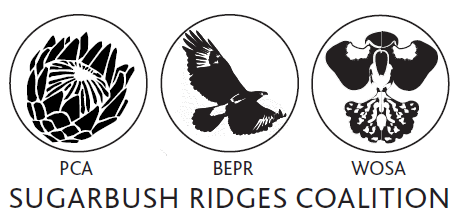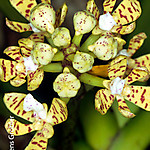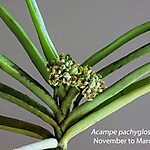Acampe
The genus Acampe contains about 10 species, one of which (Acampe pachyglossa) is found in Africa and the islands of the Indian Ocean. The other nine species are found in South-east Asia. The genus name Acampe is derived from the Greek word akampes (meaning rigid) probably referring to the brittle, fleshy flowers.
Acampe pachyglossa
Description
Acampe pachyglossa is a robust epiphytic plant, sometimes forming small clumps of four to five plants growing together. The stems are stiff and quite woody, while the roots are 6-8 millimetres in diameter. The succulent leaves are placed in two opposite rows along the stem and measure up to 250 millimetres long by 15-25 millimetres wide. The leaves are deeply folded and appear ‘vee-shaped’ in cross-section, with unequally bilobed tips. The flowers are fleshy, with pale yellow sepals and petals that have reddish-purple bands. The lip is white or yellow-white, with a few small purplish spots. Formerly known as Acampe praemorsa.
For more information regarding the preservation of South Africa's wild Orchids or if you would like to get involved please email This email address is being protected from spambots. You need JavaScript enabled to view it. or complete this short form Contact Us and we will contact you.



